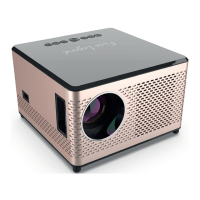11
DISPOSAL INSTRUCTIONS
This symbol on the product or on its packaging indicates that the product
must not be disposed of with other household waste. When disposing of
used devices, it is your responsibility to bring it to a collection point that
recycles used electrical and electronic equipment. The separate collection
and recycling of used devices at the time of disposal helps to conserve
natural resources and ensures that they are recycled in a manner that
protects human health and the environment. For more information about
recycling points for used devices, please contact your local city offce, household waste
disposal service, or the shop where you purchased the product.
CLEANING METHODS
Before cleaning, ensure that the power socket is unplugged. Do not use pesticides
or other volatile chemicals on the projector or lens, and avoid leaving rubber or vinyl
products in contact with the projector for extended periods of time, as this may damage
or peel off the remaining layers.
Cleaning the projector:
1. Use a soft and dry cotton cloth to wipe the surface of the projector.
2. Dampen a soft cotton cloth with a diluted neutral cleaner, and gently wipe the
projector surface. Dry with a dry cotton cloth.
3. Do not use water, benzene, or other solvents on the projector.
4. Do not scratch the main body of the projector with fingernails or other hard objects.
Cleaning the lens:
1. Blow off the dust on the lens surface, and wipe off any stains with a soft cloth.
2. Use a professional dryer or lens cleaning paper specifically for camera and glasses.
REMARKS: Do not use ordinary tissue to clean the lens. Ordinary tissue contains
large particles of impurities that may scratch the lens.
Cleaning the outlet dust filter:
Turn off the power and unplug the power cord before cleaning the outlet dust filter
of vents every three months. This will prevent poor ventilation from triggering the
projector LCD panel and COB protection mechanism.

